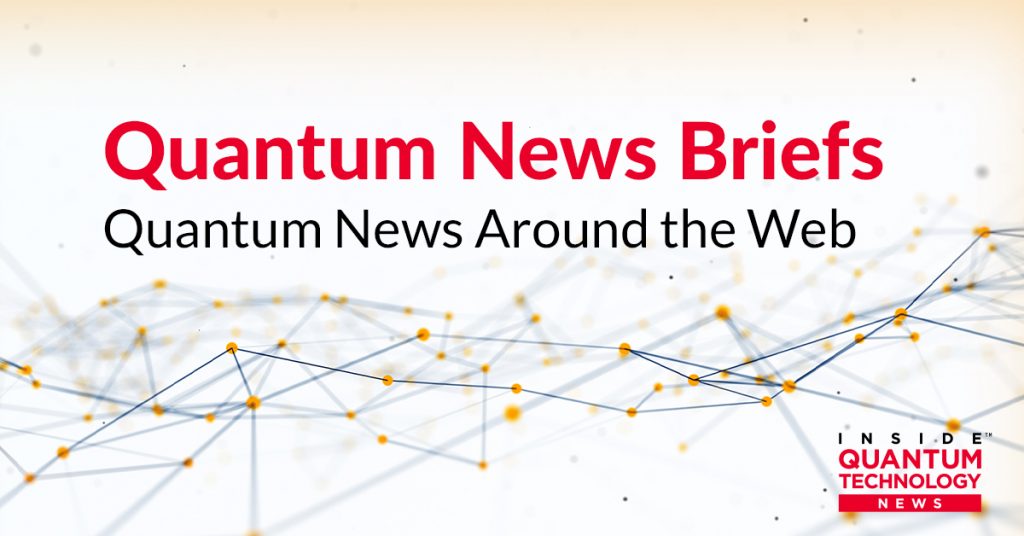Quantum News Briefs October 5 opens today with news of : Q-CTRL’s release of its Black Opal Enterprise learinng platform to make businesses ‘quantum ready’ followed by a summary QED-C Report “Public-Private Partnerships in Quantum Computing” with link to complete report. Next is new of the Quantum Information Grand Challenge Announced for Air Force Research Lab & MORE.
*****
Q-CTRL releases Black Opal Enterprise to make businesses ‘quantum ready’
QED-C Report “Public-Private Partnerships in Quantum Computing”
QED-C recently issued a report devoted to “Public-Private Partnerships in Quantum Computing”. Quantum News Briefs shares from the Executive Summary:
Quantum computing (QC) is a technology with enormous potential, but for the moment, it is one only of potential. Despite the considerable amount of QC research and development (R&D) underway, to date, no economically meaningful use cases have been demonstrated. Over time, quantum computing is likely to follow Amara’s law regarding technology forecasting—its uses and benefits will be overestimated for the near-term and underestimated for the long-run.1 This report focuses on the near-term. It evaluates potential near-term QC applications as well as the prospect of using public-private partnerships (PPPs) to accelerate the time horizon for meaningful applications of quantum computing.
The most effective way to identify a set of potential near-term QC applications of value to government is through a discovery process that involves cooperation among all stakeholders, from quantum scientists to domain subject matter experts to end users to regulators. Accordingly, the federal government should consider establishing a PPP or leveraging an existing PPP (e.g., QED-C) whose mission is to find possible near-term QC applications by facilitating planned interaction and cooperation among QC hardware and software experts, application domain experts, user communities, and policy and market experts. Such a partnership should be organized thematically around a significant area of public interest, such as climate and sustainability or public health, where there is an emerging critical mass of quantum R&D already underway.
In addition to application-focused partnerships, the federal government should consider supporting a PPP focused on addressing the underlying technology development challenges of quantum computing in a manner similar to the Department of Energy’s (DOE) Innovation Network for Fusion Energy (INFUSE) program. INFUSE awards are intended to help solve specific challenges related to fusion-enabling technology development and are awarded based on the expected impact of proposed projects on the overall progress of fusion energy R&D. Most of the technical work is performed by DOE laboratories. An INFUSE model for quantum computing would include participation of DOE’s Quantum Information Science (QIS) Research Centers and other participants from the private sector and academia and, in effect, would create focused PPPs for each approved project. Such a partnership would not address specific QC applications but the development of enabling technologies in technical areas such as qubit control, error correction, cryogenics, and system scaling, areas with broad, pre-competitive application.
The complete 56-page PDF report can be accessed by clicking here.
*****
Quantum Information Grand Challenge Announced for Air Force Research Lab
All relevant information regarding this Challenge can be found by clicking here.
Space debris is a growing concern with an exponentially increasing orbital mass that threatens operational mission sets.
This Grand Challenge aims to provide improved detection of debris objects and characterization of space objects, including but not limited to fragmentation event debris counts and enhanced definition of unknown debris objects for better classification and orbital determinations. Methodologies proposed should quantify the improvement of quantum-inspired image extraction techniques over the current state-of-the-art used by the space surveillance network.
This challenge aims to design and demonstrate quantum information extraction beyond the Rayleigh limit of the imaging system, using realistic conditions and translatable to a realizable measurement system or architecture. The challenge winner will not have to transfer their exclusive IP rights to the government to receive a contract award. Instead, they will grant Government Purpose Rights to build their solutions. This contract award is open to all US companies and US universities, participants must be “US Persons” (US Citizens or Permanent Residents).
Grand Challenge Details
What: AFRL Quantum-Inspired Information Extraction of Images Grand Challenge
When: September 27, 2022 – October 14, 2022, submission due at 4:00 p.m. (ET)
Where: Virtual
Who: Eligibility for this challenge competition is limited to US citizens and US permanent residents.
Why: Problem solvers in the field of quantum-inspired information extraction of images beyond the Rayleigh limit can win a contract up to $500,000, awarded across four phases, to develop high-resolution space imaging solutions.
*****
Australian Quantum Computing Engineers Develop SMART Qubit Protocol
UNSW engineers have substantially extended the time that their quantum computing processors can hold information by more than 100 times compared to previous results.
Now a team of researchers at UNSW Sydney has broken new ground in proving that ‘spin qubits’ – properties of electrons representing the basic units of information in quantum computers – can hold information for up to two milliseconds. Known as ‘coherence time’, the duration of time that qubits can be manipulated in increasingly complicated calculations, the achievement is 100 times longer than previous benchmarks in the same quantum processor.
“Longer coherence time means you have more time over which your quantum information is stored – which is exactly what you need when doing quantum operations,” says PhD student Ms Amanda Seedhouse, whose work in theoretical quantum computing contributed to the achievement. “The coherence time is basically telling you how long you can do all of the operations in whatever algorithm or sequence you want to do before you’ve lost all the information in your qubits.”
*****
Sandra K. Helsel, Ph.D. has been researching and reporting on frontier technologies since 1990. She has her Ph.D. from the University of Arizona.
